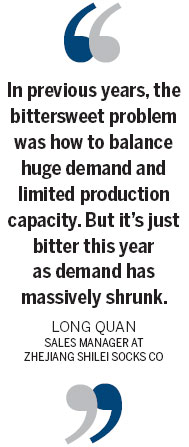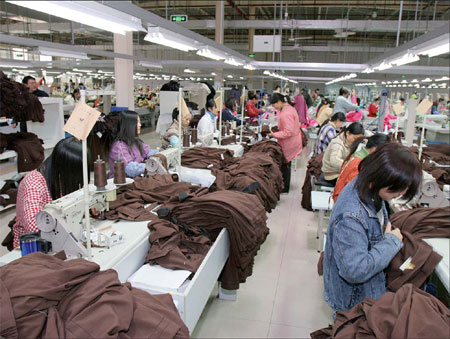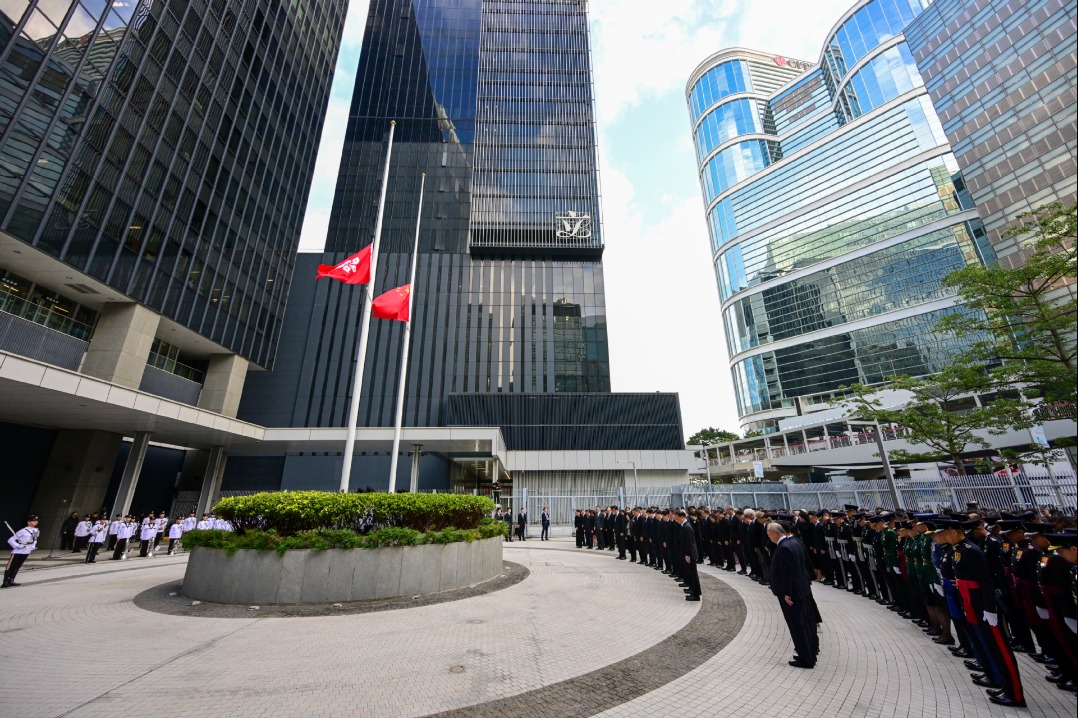Sunny front to gloomy outlook

| Workers at a clothing company in Nantong, Jiangsu province. China's exporters have mixed views about their sales next year. Provided to China Daily |

Chinese firms look at new strategies to boost exports next year
China's exporters are struggling to remain upbeat about next year's sales after a tough 2012 coping with falling demand and higher labor costs.
Only about half expect to increase their revenue in 2013, says a recent survey.
As the sales manager of Zhejiang Shilei Socks Co in Yiwu, East China's Zhejiang province, it is been a difficult year for Long Quan.
"Our company relies on exports," Long says. "In previous years, the bittersweet problem was how to balance huge demand and limited production capacity. But it's just bitter this year as demand has massively shrunk."
He says the company's annual sales revenue will drop at least 30 percent this year. Last year, it totaled more than 100 million yuan ($16 million; 11.4 million euros).
"And how worse will next year be?" he wonders.
Long's apprehension is shared by many of his peers. According to a survey conducted by B2B media company Global Sources, Chinese exporters anticipate a difficult business climate in 2013 - although many are still hopeful of increasing overseas orders.
Released on Nov 27, the survey invited 1,546 Chinese exporters from industries, including electronics, telecom and computer products, fashion accessories, home products, and garments and accessories, to forecast next year's export market.
Fifty-one percent said they expect revenues from overseas shipments to be higher next year, most estimating 10 to 20 percent growth, and several by as much as 30 percent.
But Xu Zhaoyuan, a researcher with the Development Research Center of the State Council, says the survey results do not necessarily reflect a stronger export confidence in 2013.
"Many exporters in China will consider this year's business as the worst because of the worsening economic circumstances of China's two largest trading partners, the European Union and the United States. Therefore, it is natural for them to see next year's business be better than this year's," he says.
In the first 10 months of this year, China's exports to the EU decreased by 5.8 percent year-on-year to $276.89 billion (212 billion euros). In the same period, China's total exports grew 7.8 percent to $1.67 trillion, according to statistics from the General Administration of Customs.
China's initial goal was to realize year-on-year annual export growth of 10 percent this year.
Craig Pepples, president of corporate affairs at Global Sources, says that optimism is lower than it was in a similar survey conducted a year ago when almost all respondents said they were certain of export growth.
"Many China suppliers are still dealing with higher production costs that have forced them to raise prices, which adds pressure to the already difficult export environment, with slowing business from the traditional markets of the EU and the US," he says.
Huang Buli, sales manager of Suzhou Dennis Wedding Dress Co, admits that rising costs in both materials and labor are the biggest challenges for her company.
Located in Suzhou in East China's Jiangsu province, home to China's largest cluster of wedding dress producers, the company's clients are mainly from eastern Europe, Russia, Canada and South Korea.
"In this industry, the secret everybody knows is that the so-called original designs are almost the same as everyone else's," she says. "Our competitiveness lies in production speed and relatively low prices. But it becomes harder for us to keep qualified workers if we do not increase wages. As a result, it leaves us no choice but to raise prices, which will drive many buyers away."
Huang says a top-level senior worker in her company is paid 9,000 yuan a month. The average monthly salary of workers in Suzhou was 3,355 yuan in 2011.
Researcher Xu says the most urgent mission for Chinese exporters next year is not to maintain market share or sales revenue, but to figure out a way to avoid a price war with competitors.
"Market share maintained at a cost to profits cannot last long," he says. "This is also an important issue for the whole nation to work out. The restructuring of our exports is a must.
"The dilemma faced by many exporters now over expanding production scale but shrinking profits is rooted in unsustainable production and business models."
Pepples, however, is more optimistic about Chinese exporters' performance.
"Strategies such as market diversification and upgrading product design are helping reduce the downside," he says. "Because of this, the decrease in exports earnings for most manufacturers is less than some expected."
About 27 percent of the Global Sources survey's respondents said they may launch more upmarket products to justify higher quotes.
Long says his company is focusing on introducing new fabrics to its socks to add extra value.
"Basic socks products can no longer satisfy overseas customers," he says. "Our strategy next year is to compete in the high-end market, where clients have higher purchasing power."
The Global Sources survey showed that Chinese exporters plan to continue targeting the EU and the US in 2013. Their position as China's two largest trading partners cannot be replaced by any other region within a short time, Xu says.
"So although the demand is shrinking, especially in the EU, the market is still big," he says. "Also, it seems that the economies of the EU will gradually get better next year."
Pepples says Chinese exporters intend to have a wider selection of upscale and basic products to reinvigorate demand in the EU and the US.
"At the same time, companies may pursue business in alternative destinations," he adds. "Foremost among their options is South America, followed by the Asia-Pacific region."
In the first 10 months of this year, China's exports to the ASEAN nations rose by 19.4 percent year-on-year, with an 11.2 percent growth rate for those to South Africa and 14.1 percent to Russia.
yanyiqi@chinadaily.com.cn
(China Daily 12/07/2012 page21)
Today's Top News
- Xi stresses improving long-term mechanisms for cyberspace governance
- Experts share ideas on advancing human rights
- Japan PM's remarks on Taiwan send severely wrong signal
- Key steps to boost RMB's intl standing highlighted
- Sustained fight against corruption urged
- Xi calls for promotion of spirit of volunteerism































